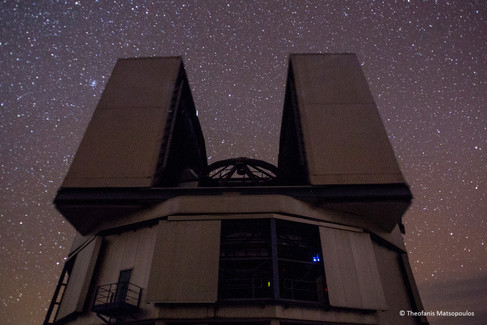Paranal: A Portal to the Deep Sky
- Theofanis Matsopoulos
- Aug 1
- 3 min read
Updated: Sep 30
In the heart of the Chilean Atacama Desert, one of the driest and most remote regions on Earth, rises a mountaintop observatory that feels more like a space station than a terrestrial facility. Paranal Observatory, located at 2,635 meters above sea level, is operated by the European Southern Observatory (ESO) and is home to some of the most powerful and advanced telescopes ever built. My visit to this iconic site was part of an official photo and video expedition for ESO in order to obtain Fulldome videos, nighttime photos and panoramas of the Observatory.

A Cathedral of Telescopes
Paranal is best known as the home of the Very Large Telescope (VLT) — a facility consisting of four 8.2-meter Unit Telescopes and four 1.8-meter Auxiliary Telescopes. Together, they form an interferometric array capable of observing the universe in exquisite detail. The VLT has helped astronomers study the formation of stars and galaxies, directly image exoplanets, and even observe the environment near a black hole at the center of our galaxy.

The architecture of Paranal is as remarkable as its instrumentation. The telescopes rise like sentinels from the mountaintop, engineered to function in extreme conditions, with each dome opening to reveal a carefully choreographed dance of mirrors, lasers, and optics. Filming these mechanical giants in motion — silhouetted against a sky glowing with southern constellations — was nothing short of awe-inspiring.

Harsh Beauty of the Atacama
But working in this environment is not without its challenges. The Atacama Desert is the driest non-polar region on the planet. Some areas have gone decades without rainfall. The intense dryness preserves the atmosphere’s clarity, making it ideal for astronomy — but tough on people and equipment. At this altitude, the sun is harsh, the air is razor-dry, and even the simplest task demands careful hydration and stamina.
Camera gear is constantly exposed to dust and sudden temperature shifts, and long night sessions require both physical endurance and technical precision. But despite the demanding conditions, the reward is unmatched: a night sky that appears almost alien in its clarity, with the Milky Way stretching horizon to horizon, brighter than in almost any other place on Earth.

A Global Collaboration
Paranal is not just a scientific outpost — it is a symbol of international collaboration. Operated by ESO, it represents the collective effort of European nations to push the boundaries of astronomical discovery. It also serves as a critical node in the global infrastructure of observatories, complementing nearby facilities like Cerro Tololo, Cerro Pachón, and La Silla — many of which I’ve also visited and documented during my ongoing expeditions.
Capturing the Future
As part of NOIRLab’s broader mission to support public engagement through science visuals, this expedition to Paranal contributes to a growing archive of immersive, high-resolution content for use in planetariums, museums, educational platforms, and more. My role is to help translate the precision and grandeur of these facilities into visual stories that spark wonder and understanding in audiences around the world.
Paranal is a place where the frontier of astronomy is redefined nightly. To stand beside the VLT as it unlocks the deep sky — and to capture that experience for others — is a rare privilege. There’s more to come, including time-lapses, behind-the-scenes visuals, and nightscape images from this remarkable journey.
















